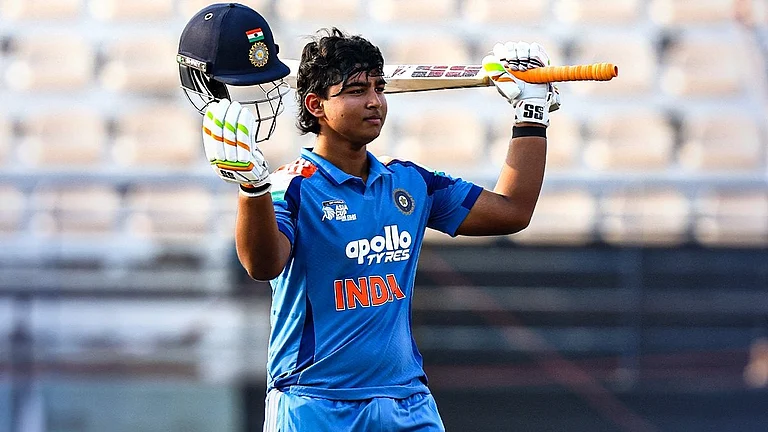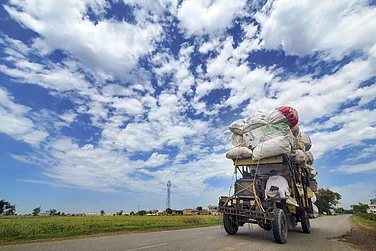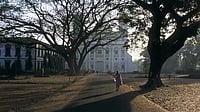“Education is like milk of the tigress, one who drinks it can't stop roaring.” –Dr B R Ambedkar
Dr Ambedkar always emphasised the idea of emancipation and empowerment via education, especially in a gendered sense. His life was a saga of painstaking efforts to transcend the graded, hierarchical caste system and elevate himself as well as society in order to reach a teleological end of manuski. Ambedkar initiated a means via a counter-discourse to radically alter the discourse of modernity forever. Everybody is aware of his humane assertion against the so-called force majeure of Brahmanical hegemony and his movement to create an India based on the tenets of Constitutional morality.
Post-1990s, the revival of interest in Ambedkar's writings is astounding. From being a pariah reduced to a footnote in Civics textbooks, passingly mentioned as a background player within Gandhian mass nationalism i.e., relegated to only the episodic Poona Pact, today, he is being appropriated by all ideologies be it right, left or centre, or their innumerable permutations and combinations. His writings are selectively dissected, taken out of context and used to suit sinister motives or contemporary requirements. This is evident especially in conservative magazines and portals, wherein the writings of Ambedkar, using appropriated Dalit intellectuals (by making them part of the dominant political party's perks and privileges) are relied on to achieve legitimacy for the claims of the very populace who had historically practised the strategy of hate vis-a-vis Ambedkar.
In this short span, a number of works have been published on Ambedkar ranging from an English translation of the autobiography by Ambedkar's partner Savita Ambedkar, a book by Congress member Shashi Tharoor to writings of scholars like Scott R Stroud. Within this arena, scholar Akash Singh Rathore presents his book, Becoming Babasaheb: The Life and Times of Bhimrao Ramji Ambedkar (Volume 1): Birth to Mahad (1891-1929). This important work tries to bring Ambedkar to readers as a person, and his journey of becoming the beloved Babasaheb of the oppressed masses. Only the first volume has been released (from Ambedkar's birth in 1891 to 1929). This is divided into fifteen chapters with a detailed bibliography and four appendixes. There is a section on notes as well as rare photographs related to Ambedkar.
I attended Rathore's presentations for this book and got to know the modus-operandi he followed for creating it. He claims to have worked by reverifying primary source materials from the original institutions rather than relying on earlier available research. Writing a biography of Ambedkar is a huge as well as a paradoxical task. Also, there have been instances of selective approach of using Ambedkar and his writings for constructing myths as employed by the Marathi biographer Dhananjay Keer, who was a devotee of V D Savarkar. Thus, he portrayed Ambedkar as belonging to the same school of intellectual thought as of Savarkar. Then there is a range of classical writings by Eleanor Zelliot which became a point of reference for intellectuals with a Marathi to English research background, a very different Ambedkar Seeking Begumpura, laden with manuski by Gail Omvedt and works by Christophe Jeffrelot. Short biographies by C B Khairmode, B C Kamble and Shankar Rao Kharat were available in Marathi which served as primary source material for these biographers.
Rathore points to the numerous inaccuracies in source materials referred to by the above-mentioned biographers and other writers. To show how paradoxical the situation is, he produces a letter from the London School of Economics which provides a wrong date to Khairmode and thus, sets off a domino effect of a series of factual errors in dating Ambedkar's intellectual journey. Thus, the primary source of all later biographies i.e., Khairmode's work, carries forward the same errors. Rathore states that Ambedkar himself gets some dates wrong and adds to the already existing chaos. This discourse on source reliability is very interesting as it points to the loopholes in studying and locating Ambedkar and his thoughts.
Chapter 1 of Rathore’s book talks about personal biographical details of Ambedkar’s life but gets entangled too much in source correctness and facts. Here, Rathore sometimes loses the essence of the emotive and humane side of Ambedkar. Perhaps a cue could be taken from Baburao Bagul's Marathi work Ambedkar Bharat 1 and Ambedkar Bharat 2. If looked at from Rathore's source reliability paradigm, it may not qualify to be a part of his project but Ambedkar as a person is the crux of Bagul's writing and this is what Rathore is trying to do too. Bagul writes about Ambedkar reading Charles Dickens and his determination to read all the great classics. When he tells his father he is reading Dickens, he gets an earful and is ordered to study for his upcoming exams. This incident immediately connects a layperson to Ambedkar's world and makes her understand the pain of his unfulfilled wish of being a litterateur. He was denied the opportunity to study Sanskrit and that kept him out of the intellectual space to pursue his dream. Thus, the caste system killed his innate desire to pursue literary writing. Rathore points to Ambedkar's love for theatre and Shakespeare and its deployment to fund his Mahad Satyagraha. But missing from Rathore’s book is the memorable detail of Ambedkar drawing inspiration from Napoleon's biography.
In Chapter 2, Rathore fills some of the lacunas mentioned above by personalising Ambedkar’s experiences of questioning the origin of the caste discourse, which later feminist theories have put emphasis upon. This is evident in the rebellion of Ambedkar vis-a-vis Ramayana and Mahabharata and also in his questioning of his father. It brings out the nuances of the relationship between the father and son, an acknowledgement of the intellectual side of Ambedkar as well as the debates between them.
Chapter 3 brilliantly puts forth gender and race as an important realm for Ambedkar and his works. This is particularly crucial today as certain Dalit, as well as non-Dalit authors for petty popularity, are racialising Dalits using Ambedkar as an agency, which shows the hunger for populism and acceptance by dominant intelligentsia. A primary yet nuanced reading of Ambedkar shows that he differentiated clearly between race and caste. But Rathore misses the opportunity to dwell upon this idea which could have been instrumental in bringing out a gendered Ambedkar and de-racialising contemporary discourse on him.
A very important aspect of Ambedkar highlighted here is to put to rest the connection between Ambedkar and Marx or to be precise, questioning Ambedkar's legitimacy to critique the Left. Rathore shares that Ambedkar extensively studied Economics under Vladimir Simkhovitch, the professor's dominant idea of equality of opportunity for women and took five full courses on Marxism and Socialism at Columbia University. V Geetha in her recent work draws attention to how Ambedkar pursued the broader idea of Left and Socialism. In Chapter 6, Rathore shines a light on Ambedkar’s affinity with the labour movement and, in brief, his relationship with N M Joshi. Chapter 15 focuses on Ambedkar's systemic critique of the Indian Left. Here, the author's hard work and eye for detail pays off handsomely to clear the cobwebs surrounding Ambedkar and the political Left not sharing an antagonist relationship. The reference notes that Rathore provides are valuable.
Chapter 5 details Ambedkar’s return to India and his infamous time at Baroda. It focuses more on correcting factual inaccuracies that have cropped up in mapping Ambedkar's life. Rathore points out that when Ambedkar returned for the first time to India, he only had an M.A., with his doctorate pending. His MSc thesis submission was pending. It's appreciable that the author has painstakingly
shared such minute details but the tone of Rathore’s writing is sarcastic at times. Rathore tries to substantiate his argument by citing Prabhar Padhye's version which shares his memory of Ambedkar, but as I pointed out earlier, only valid references and citations can't bring out the persona or humane side of the subject of a biography. Perhaps, the tone of Rathore’s book could have been better if conceived from an empathetic paradigm, wherein an outcaste without any socio-cultural capital and even lacking economic capital, navigating all hindrances and armed with a quest for knowledge, fighting a lone battle for reclaiming manuski, has to abruptly pause his studies and return to India owing to the lack of money as well as a series of personal problems (which Khairmode's Marathi work has mentioned too).
In Chapter 7, Rathore examines Ambedkar's relationship with Chatrapati Shahu of Kolhapur who was instrumental in shaping Ambedkar as Babasaheb. This chapter could have been more enriched if it had dealt with the Vedokta controversy, which turned Chatrapati Shahu into one of the pioneers of the non-Brahmin movement in Maharashtra. This could have better explained why Shahu Maharaj introduced reforms in the realm of education, marriage and representation for non–Brahmins in his administration and linked it with the natural corollary to support Ambedkar as well when he seeks Ambedkar's help to weigh in on the matter of lodging a civil or criminal case against B G Tilak. Again, facts aren't panache a for all the misses, but organicity and principled linkages to ideological predecessors can play a major part in shaping a person. The Vedokta controversy occurs vis a vis the Maharaja of Baroda and the Maharaja of Kolhapur both of whom played an important part in shaping Ambedkar as a person. In fact, Ambedkar returns to this theme in his later classic, Who Were the Shudras? (1946). This seems like a lost opportunity and I hope Rathore incorporates it in the upcoming volume.
Other chapters shed light on Ambedkar's return from London and reworking his thesis. Rathore debunks the earlier sources, especially Khairmode, and corrects the facts related to Ambedkar's academic journey. After returning to colonial India, Ambedkar is a pariah in the Bombay High Court, nevertheless, he continues to fight for the marginalised strata of society. Here, Rathore mentions an incident from Rohit De's book. In Chapter 11, he speaks about the Bahishkrit Hitakarini Sabha and its mouthpiece Bahishkrit Bharat, highlighting its role in carving out a different idea of the public sphere by sending out the message of Educate, Agitate and Organise. This chapter is interesting because Rathore provides a critique of Christophe Jaffrelot's biographical analysis and is also critical of Jeffrelot's Eurocentric view.
He covers in the further chapters the evolution of the equation between Ambedkar and Gandhi, claiming that Ambedkar appreciated Gandhi in certain instances like in his speech at Jejuri, Maharashtra. Ambedkar criticised Gandhi too for his selected activism and limiting acts, and for upholding the varna system rather than launching an all-out attack to annihilate caste, in his speech at Nipani, Karnataka. Rathore brings out Ambedkar's persona as a multifaceted one by providing citations of Ambedkar’s quotes from the Bible and references to Bhakti saints like Tukaram and Chokhamela in his work as well as in his personal correspondence. This shows that the study of religious texts and their philosophy was Ambedkar’s lifelong project and a deep reflection of his pragmatism and open-mindedness.
In the remaining chapters, Rathore mainly focuses on Ambedkar's visit to Bhima Koregaon, which he used as the symbol to uphold the bravery of the Mahars and to give a sense of pride to Dalits. This visit has today transformed Bhima Koregaon into the epicentre for Dalit assertion. Rathore's rich details clarify how Ambedkar creatively used symbolism as a source of agency for Dalits to imbibe a sense of pride and self-respect. This is evident in all his public speeches and writings. His studies in Columbia in History and Philosophy may be the key to creatively using history as an alternative retelling for the resurrection of the broken people who have been fed mythology as history. As a critical reader, it makes me ponder why the State got so actively involved in the Bhima Koregaon episode. How a single victory pillar and a geographical spatiality just a few kilometres away from the hub of Peshwa rule i.e., Pune, could be interpreted as a threat to law and order. Rathore provides details in his book to raise the critical and interpretive bar of the reader.
Another important chapter is on the Mahad Revolution, which for Ambedkar was comparable to the French Revolution. Interestingly, Rathore gives the story of pre- and post-Mahad Satyagraha along with Ambedkar's approach in these phases. How the performing arts were used to raise money for the conference. The performing arts played a critical role in the dissemination of Ambedkar's message to the masses. Certain instances are well documented where there is a clash between Satyashodhak activists and their opposition to including Brahmins in Mahad Satyagraha, irking Ambedkar. Rathore’s references to Comrade R B More's recently published memoir make it replete with minor details and provide an interesting read of the Mahad event. Rathore mentions the hailing of Shivaji, Mahadeva and Gandhi during the drinking of water from Chawdar tank in the Mahad Satyagraha. But it laid bare the fractured idea of Hinduism when purification rituals were carried out later.
As Gandhi also becomes prominent and worth mentioning, Rathore could have delved into more details from Bojja Tharakam's classic work on the Mahad Satyagraha which would have made the chapter richer. The assassination attempts, particularly the incident of Ambedkar being targeted at Raigad Fort, stand out. These are not adequately covered in earlier biographies. There have been critiques of Ambedkar's approach post-Mahad violence, which if reflected either in the notes or the bibliography would have helped readers to get a wider perspective. Rathore's book presents Ambedkar's modus-vivendi as pragmatic or majjamika. Ambedkar's schema of dealing with violence post-Mahad Satyagraha, where Dalits were attacked brutally by the upper castes, both intellectually as well as legally is skillfully portrayed by Rathore. It shows how Ambedkar weighed the pros and cons before taking any emotive, passionate or inner call, which separates him from other mass leaders and their whimsical decisions.
Rathore painstakingly analyses the archives of newspapers and contemporary publications along with Ambedkar’s letters and speeches. He puts them in chronological sequence to fit into the biographical format, filling important critical gaps as well as making it easy for even laypersons to read and understand Ambedkar's saga. Rathore’s Volume 1 pauses at the point where Ambedkar metamorphosises into the beloved and revered Babasaheb of the untouchables. Rathore includes rich bibliographical details as well as an English translation of the Marathi table of contents of C B Khairmode's volumes. As a student of literature, law and history, I feel this book is an important addition to the available biographical literature on Ambedkar. Though scholarly and researched meticulously, the tone of writing seems akin to active rebuffing of the earlier works. These critiqued earlier works with all their flaws (unconscious ones as well as those arising from limited availability of resources) are equally a product of painstaking efforts by authors such as Khairmode, Zelliot, Omvedt and Jeffrelot and timely intervention. It was these scholars who, with their limitations, worked the hardest when there was a dearth of biographical scholarship on Ambedkar.
Akash Singh Rathore raises the bar high in the post-truth world, presenting Babasaheb in a critical and scholarly manner rather than offering a simplistic reduction of ‘us versus them’ or just writing a hagiography. He demolishes the conscious construct of Ambedkar and his appropriation by conservative ideological forces, pointing to the available archives and their incorrectness, reverifying the claims made earlier and making the ‘best use of his own inherited socio-cultural and economic capital in a constructive manner’ through hard intellectual and physical labour to present the trajectory of Dr Ambedkar’s journey in a new light.
(Nikhil Sanjay-Rekha Adsule is a senior research scholar at IIT-Delhi, Dewey Emerging Scholar, USA and DAIC Fellow, Ministry of Social Justice & Empowerment)


























